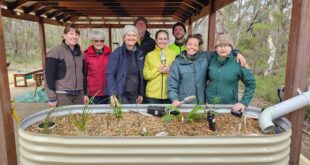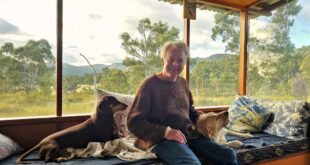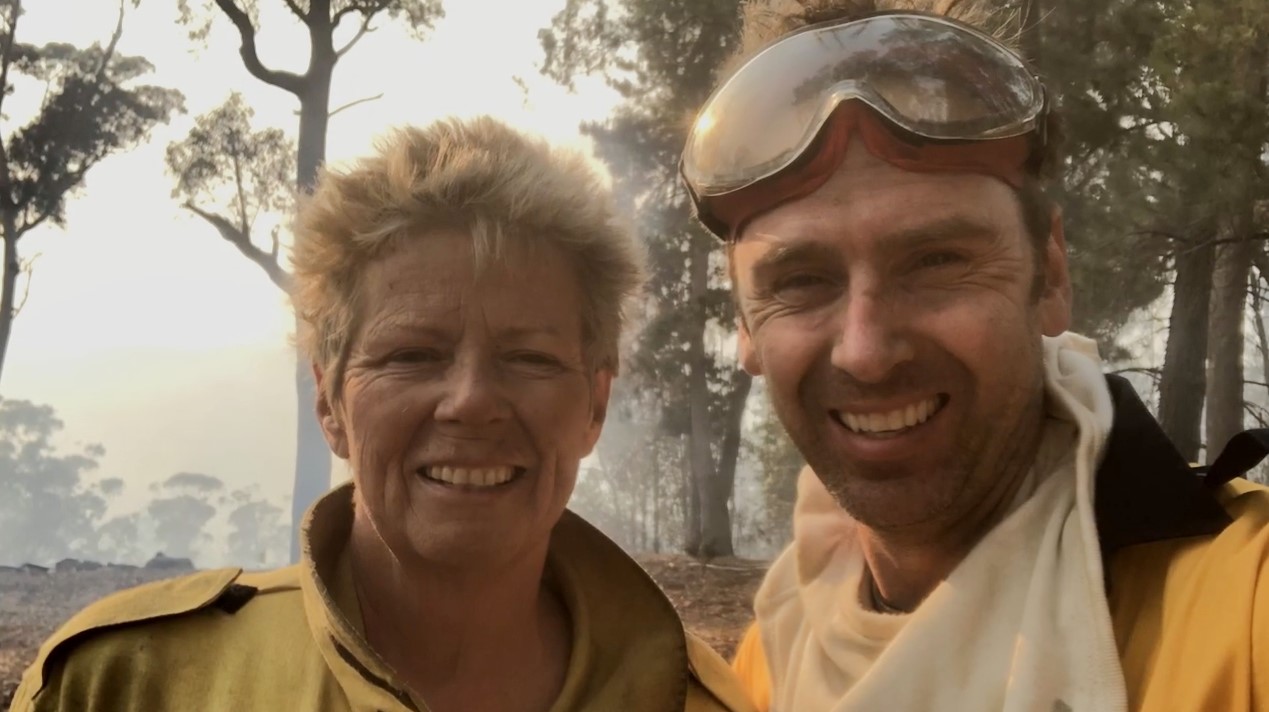
Karen Cody and Tyson Salijevic in December 2019.
Story by Hamish Dunlop. All video stills via ABCD Inc.
The villages of Bell, Clarence and Dargan found themselves in the path of two converging fires at the end of 2019. Afterwards, the communities engaged fire consultant Tony Hawkins and produced three videos on how to make your property more resilient in the face of fire.
Key Points:
- With the help of a Disaster Risk Reduction Fund (DRRF) grant, the Association of Bell, Clarence and Dargan (ABCD Inc.) has produced a series of videos that support the community to be more prepared for bushfire. The DRRF is jointly funded by the Australian and NSW governments.
- ABCD Inc. employed fire consultant Tony Hawkins to lead workshops on making homes and properties in their communities more resilient in the face of fire.
- The New South Wales Rural Fire Service (NSW RFS) website is also an excellent place to find resources about how to make you home and property more fire resilient.
Introduction – living with fire
Karen Cody is the Vice President of ABCD Inc. and a ten-year resident of Dargan. She was drawn to this area by its wilderness, expansive views, and the three colourful communities that ABCD Inc. represents.
Bell, Clarence and Dargan are small forest villages on the highest, most western ridge of the Blue Mountains and home to approximately 330 people. It’s an area surrounded by deep canyons, dense vegetation, single roads in and out and a very high fire risk.
There have been two major fire events in the last 10 years. The first was the State Mine Gully fire in 2013, followed by the Gospers Mountain fire in 2019.

An aerial view of the most western ridge of the Blue Mountains.
In December 2019, the fires struck the three villages leaving a trail of destruction. All roads and streets were blocked, leaving no escape route to Lithgow, Sydney or Mount Victoria. The fires claimed 108 buildings across the three villages.
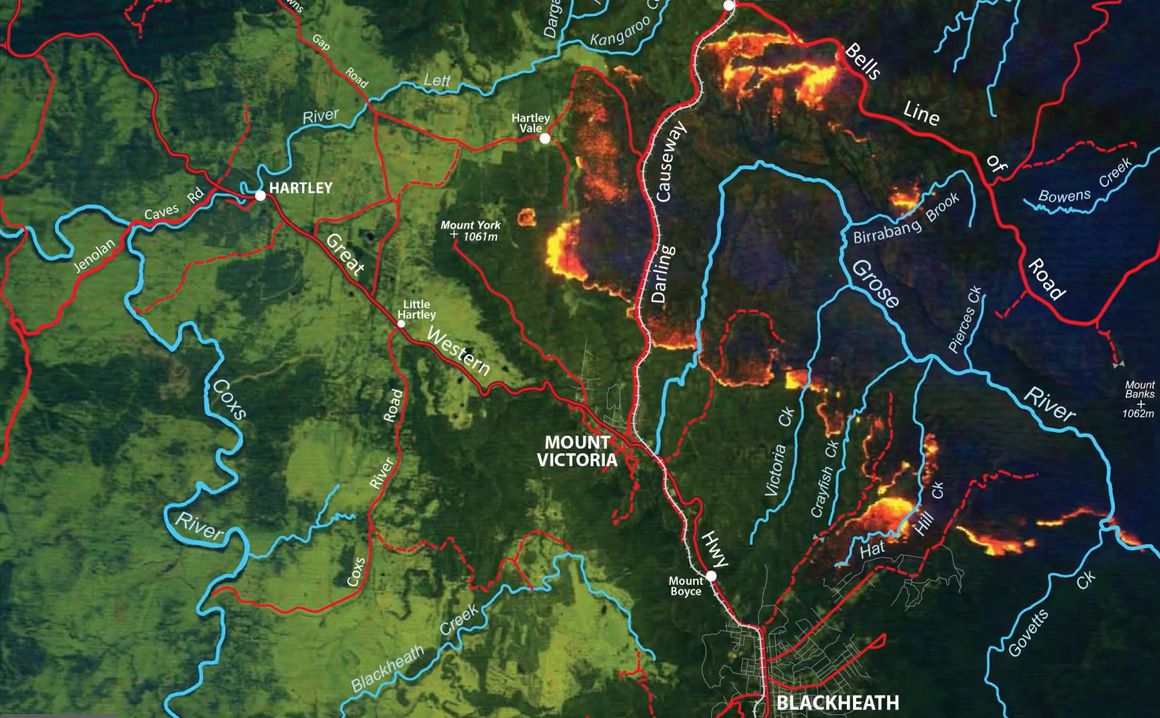
A map of some of the areas hit by fire in the last 10 years.
After the fires, people had to decide whether to stay and rebuild or move away. One of the big questions for everyone was, “What can we do to ensure our homes are more resilient in the face of the next fire?”
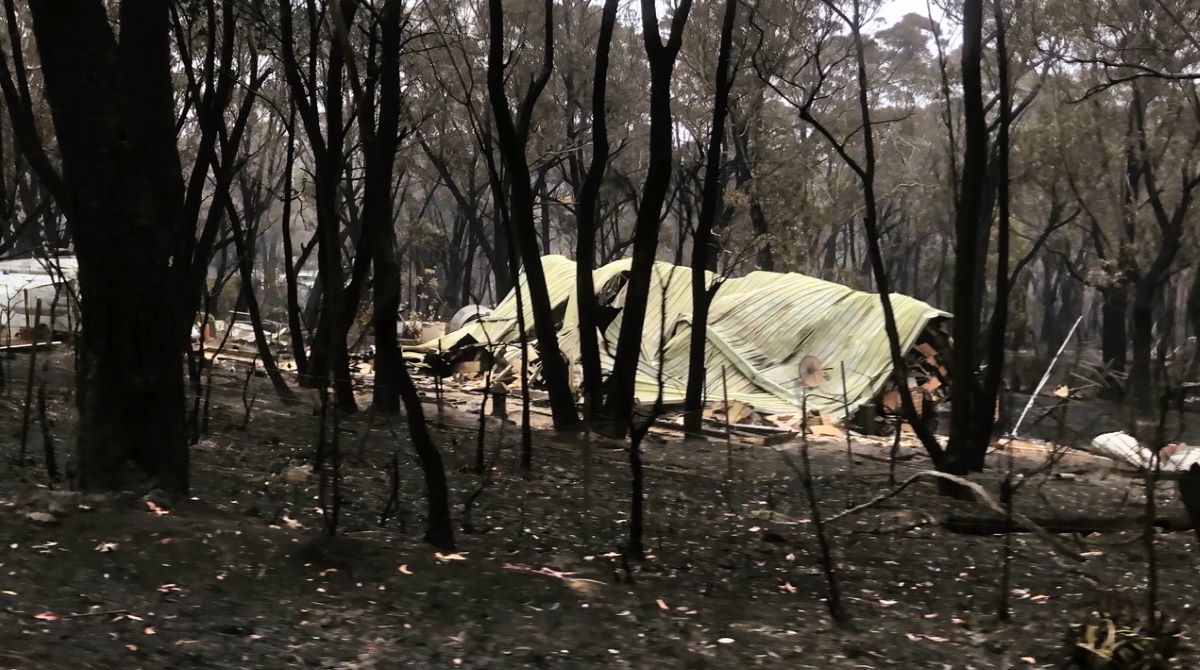
After fire.
Discussions took place about who was responsible for what land around the villages. For example, the Crown, Council and National Parks, all own land in the area. Infrastructure providers for road and rail corridors and private landowners also had responsibilities. In terms of private properties, the community wanted to reduce their risk, protecting themselves, their neighbours, and their communities at large. They needed help prioritising bushfire risks and identifying cheap and easy solutions to fix them.
The communities would like to see the Rural Fire Service (RFS) develop a best practice Community Protection Plan consistent with RFS guidelines and involving substantial community consultation.
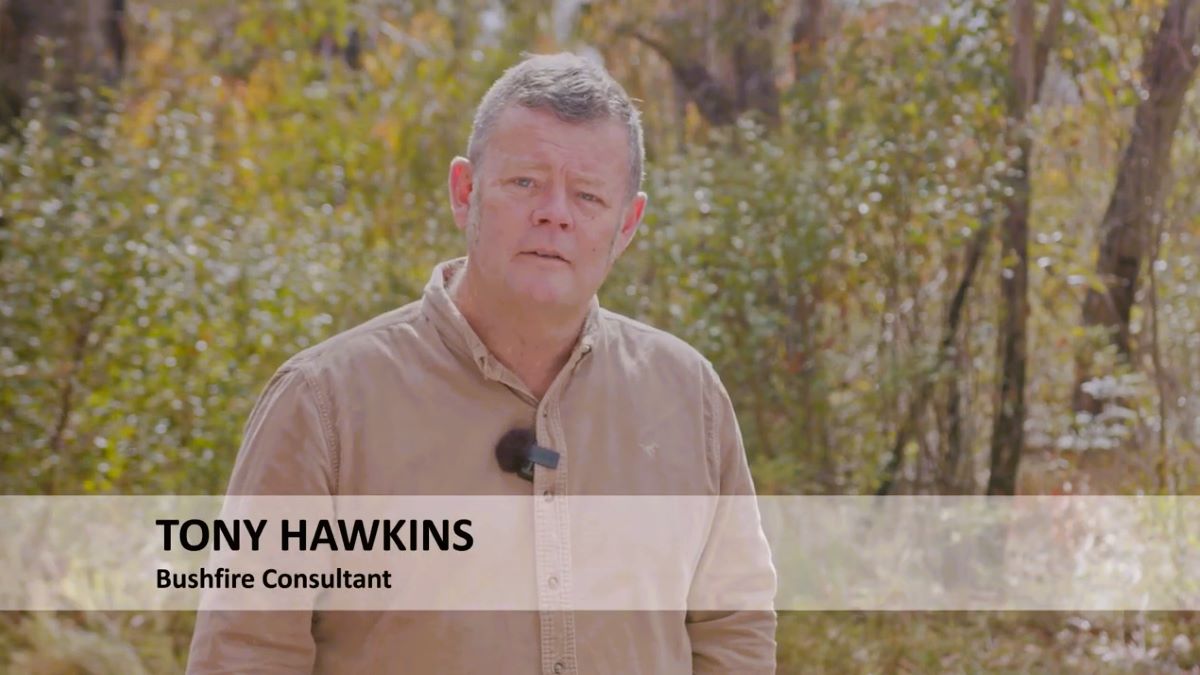
Bushfire consultant Tony Hawkins
Fire consultant Tony Hawkins was engaged to help. These are the lessons learned: how to understand fire preparedness and how to improve our properties.
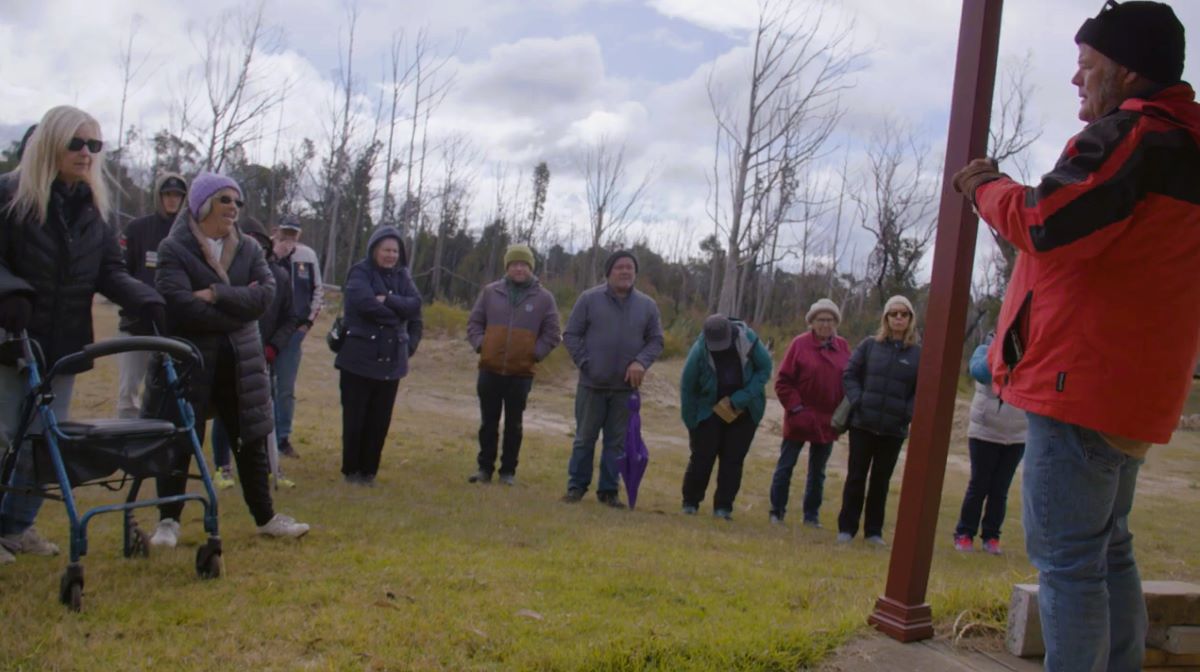
Fire consultant Tony Hawkins speaking at one of the community workshops.
Video #1
Video #1 covers the standards your home needs to be built to in order to resist fire. It also covers the importance of an Asset Protection Zone (APZ) around your home. There is a section on Legislation, Regulations & Codes and links to more information on the NSW Rural Fire Service website on specific topics.
Preparation begins long before fire comes
Know your Fire History: Your area may have experienced bushfires before. Understanding how fires affected your property previously can inform how you prepare for future events.
Fire doesn’t always travel in the wind’s direction. Gullies can shape the path of fire by funnelling wind. Fires are generally more dangerous when they travel up gullies and slopes, but fires travelling downhill can still be dangerous.
Know your BAL Rating: BAL stands for Bushfire Attack Level. It is an Australian government standard that measures the potential for your home to be exposed to bushfire attack.
BAL ratings correspond to individual construction standards. The aim is to provide a house that will enable you to survive the bushfire front. Bushfire Attack Levels range from BAL Flame Zone at the top, BAL 40, BAL 29, BAL 19, BAL12.5 and BAL-low. Each level has a corresponding construction standard.
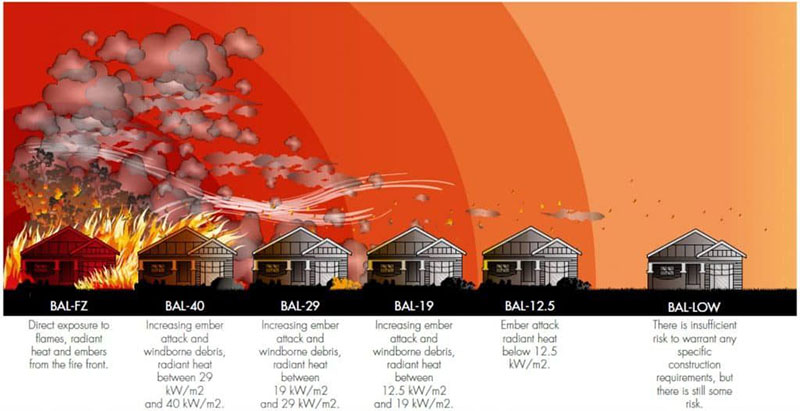
BAL ratings
How your home is impacted depends on various factors, including how close vegetation is, what vegetation types are present, the slope of the property, and the undergrowth conditions.
A BAL Flame Zone standard applies if your house could be exposed to flames directly. The subsequent BAL ratings address radiant heat. A BAL 40 rating, for example, refers to the ability of a structure to withstand 40 kilowatts per square metre of radiant heat.
To give you an idea about how hot this is, 1 kilowatt is equivalent to the radiant heat generated by a single bar heater. A BAL 40 rating reflects the need for a structure, or parts of a structure, to resist the heat of 40 single bar heaters per square metre.
MORE INFORMATION about Bush Fire Attack Levels can be found at:
Managing your Asset Protection Zone
One way to reduce your home’s BAL rating – its susceptibility to flame and radiant heat attack – is by having an Asset Protection Zone (APZ). An Asset Protection Zone is a fuel-reduced area surrounding a built asset or structure.
Vegetation types: In an APZ, you can have a certain percentage of shrubs (generally around 10%), trees, and very limited material on the ground. Tree canopies need to be separated by 2-5 metres. With limited material on the ground, it is more difficult for canopy fires to get started and continue burning.
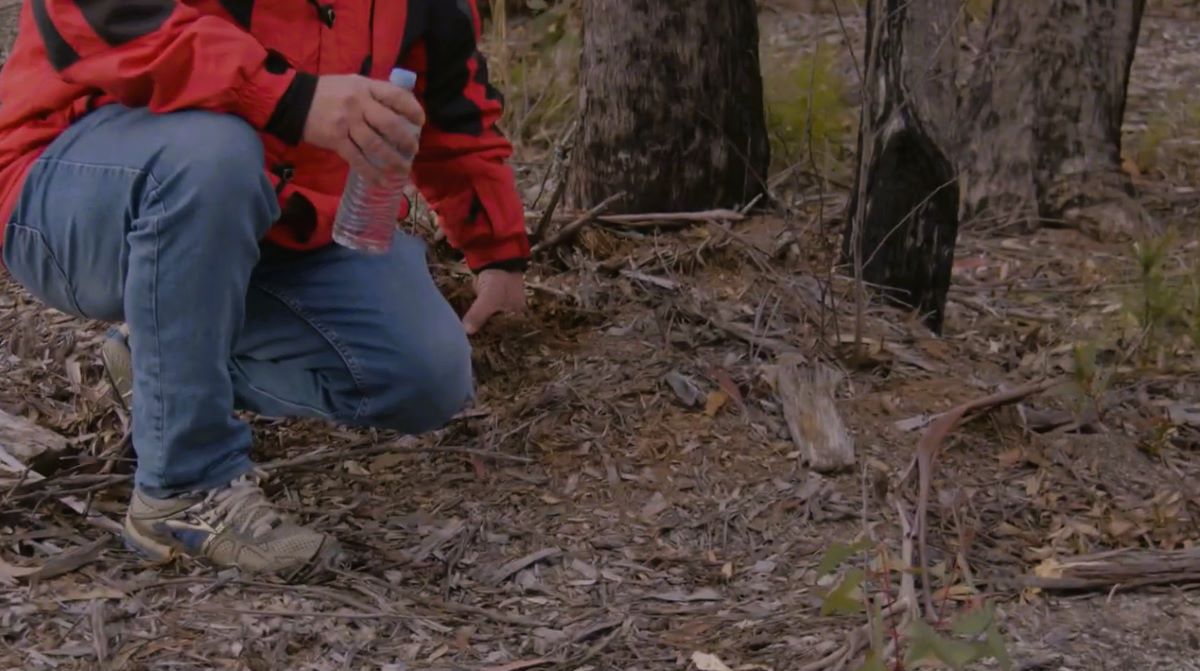
Tony indicating there is too much combustible material on the ground in the APZ.
Wind speed reduction
Kevin McCusker, Deputy Captain of the Clarence/Dargan RFS says well-placed trees can potentially slow the wind speed that magnifies a fire’s progress, and potentially trap embers that can ignite fires inside dwellings.
Limiting erosion
Stripping the land by removing all trees opens it up to the forces of erosion. Leaving some organic matter on the ground, such as whipper snippings, can slow the flow of water. It can stop the action of rain directly on the land. A felled tree can be laid across a slope to help resist erosion by wind and water.
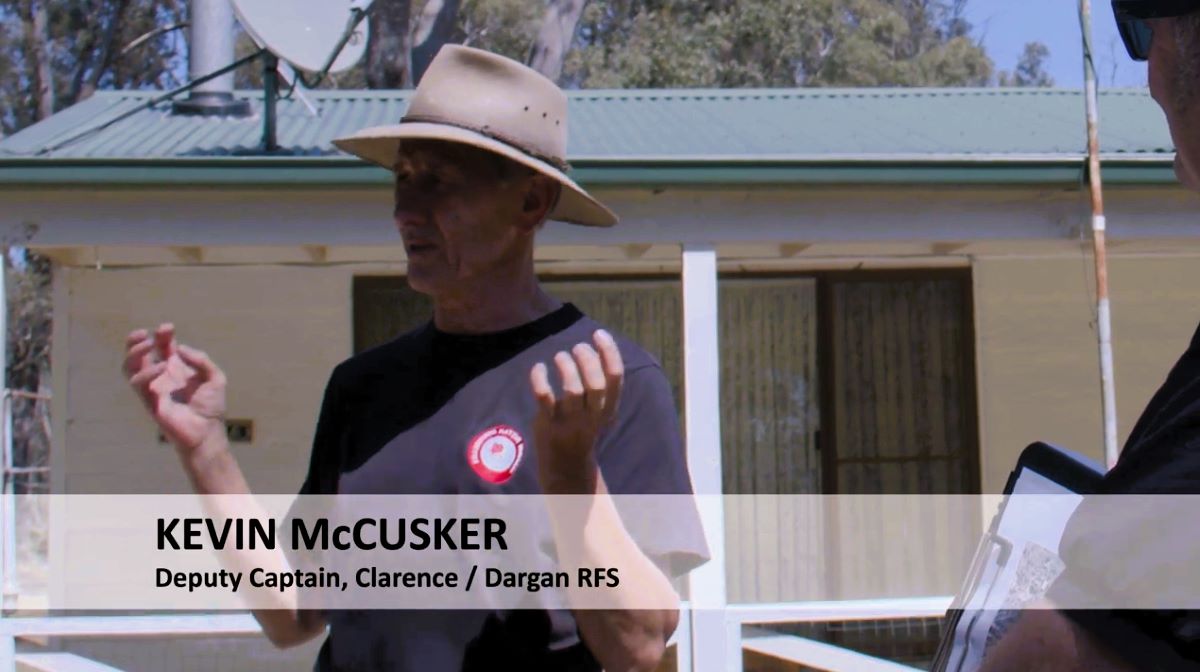
Kevin McCusker talking about how trees can potentially slow wind and catch embers.
More information about Asset Protection Zones can be found at:
https://www.rfs.nsw.gov.au/data/assets/pdffile/0010/13321/Standards-for-Asset-Protection-Zones.pdf
Legislation, Regulations & Codes
The NSW Rural Fire Service is an excellent source of information about how to prepare for bushfires.
The Blue Mountains City Council has a Development Application (DA) tracking service on its website. This service may allow you to find the original DA with the associated APZ and BAL build standards.
10/50 Code
The 10/50 Code specifies your ability to clear vegetation on your property under the 10/50 Scheme. The online assessment tool provided by the NSW Rural Fire Service can help you assess whether the 10/50 Code is applicable to your property. Criteria such a heritage value, the presence of threatened species and slope determine whether the 10/50 Code can be applied.
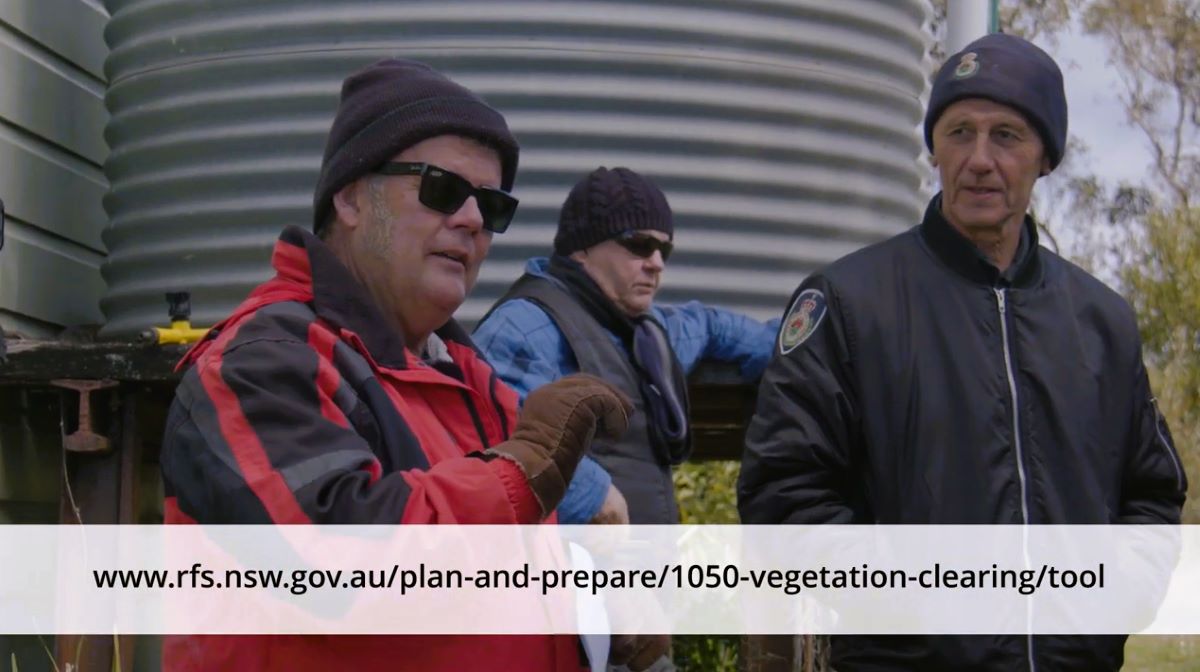
Tony talking about the 10/50 Code.
If you can’t use the 10/50 Code and you want to clear for asset protection, another option is to apply for a hazard reduction certificate. Information about this and how you apply for a certificate can be found here.
Property access
Another factor to think about is access to your property. This is vital in enabling you to leave your property in an emergency. It’s also vital for firefighters and their vehicles to undertake firefighting. If you’re more than 200m from a road, you need a second way out.
Features such as having wide enough gates for fire vehicles, access to water, and room around your home to make firefighting easier, are all important considerations. One significant change is having a clear property number on the road. This makes it easier for firefighters to find you.

Looking at the gate to see if it’s wide enough for firefighting vehicles.
Multiple factors reduce risk
When considering the risk of fire, it’s important not to rely on just one feature of your property, just the APZ for example. Mitigating against fire includes making your home more fire resistant, thinking about your APZ and other factors as well.
More information about building and living in a bush fire area can be found here including the document: PLANNING FOR BUSH FIRE PROTECTION: A guide for councils, planners, fire authorities and developers.
Video #2
Video #2 covers common issues with homes that make them more vulnerable to fire. Common problems include gaps and the vulnerability of glass to radiant heat and flame attack. Solutions are proposed such as mesh to keep embers out and shutters and sprinkler systems to protect homes from a variety of challenges.
Preparing your home for bushfires
Here are some ways you can improve your home’s bushfire resilience.
One of the most important things to consider when looking at the construction of your home is gaps where embers can enter. Windows are another major area of vulnerability. These suggestions are meant to draw your attention to potential problem areas around your home. How you best solve them might differ from what other people do. Sprinkler systems can effectively protect some of the most fire-susceptible parts of the home.
Windows
Windows are the most vulnerable part of your house. Glass is very fragile and with one crack, fire has an entry point. This enables embers to enter and burn the house down from the inside out. In a bushfire, a significant percentage of houses burn down due to ember attack.
The higher the BAL rating in the building standards, the thicker and tougher the glass must be. Meeting the standards with glass alone becomes increasingly expensive. Shutters and metal screens are two other ways to address the problem.

Shutters on a local’s windows.
The cheapest window protection in an emergency situation is roofing iron. Other options that can be installed include sliding and motorised shutters and screens. However, anything motorised including shutters and gates can stop working if the electricity supply is interrupted by fire.
Ventilation
There is a balance between sealing a building and having sufficient ventilation to stop moisture from being trapped inside. The challenge however, is that gaps allow embers to enter areas like roof spaces.
Roof ridge capping helps keep out embers, but it also creates gaps. Relatively fine mesh like a traditional metal fly screens can block holes, while allowing the house to ventilate. Whirlybirds and extractor fans are other ventilating features that can facilitate ember attack. Newer extractors have vents that close when they are not in use.
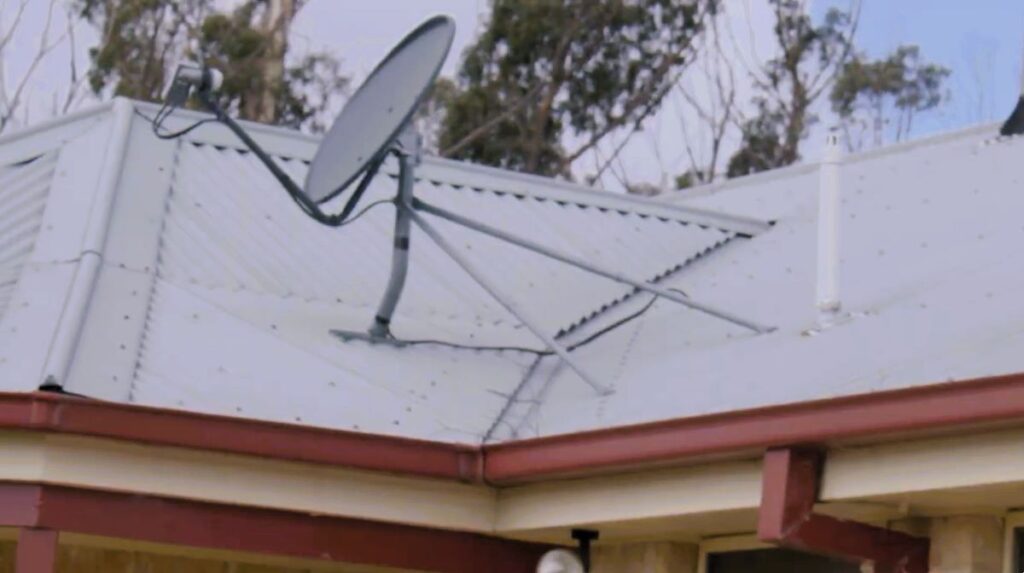
Tony pointing out gaps in the roof where embers can enter
Mesh can also be used to fill gaps between bricks. Cut a section of mesh as long as the gap. Fold the mesh piece in half and insert it, fold outward, into the gap. Solid wooden doors are best to resist fire. Having screens over the doors increases their resilience. It’s important to have a seal at the bottom of doors to stop embers from entering and mats should be removed when fire is imminent.
Roller Doors
Spaces above roller doors and where they connect with the garage floor both need to be sealed. Brand new doors often come with sealing mechanisms, but it is possible to retrofit older doors with off-the-shelf solutions.
Exposed timber
There can be exposed timber joists under houses. Decks and verandas are also susceptible to fire. Embers can land on them and continue burning. One solution is to cover a home’s underside with something non-flammable, such as fibre cement.
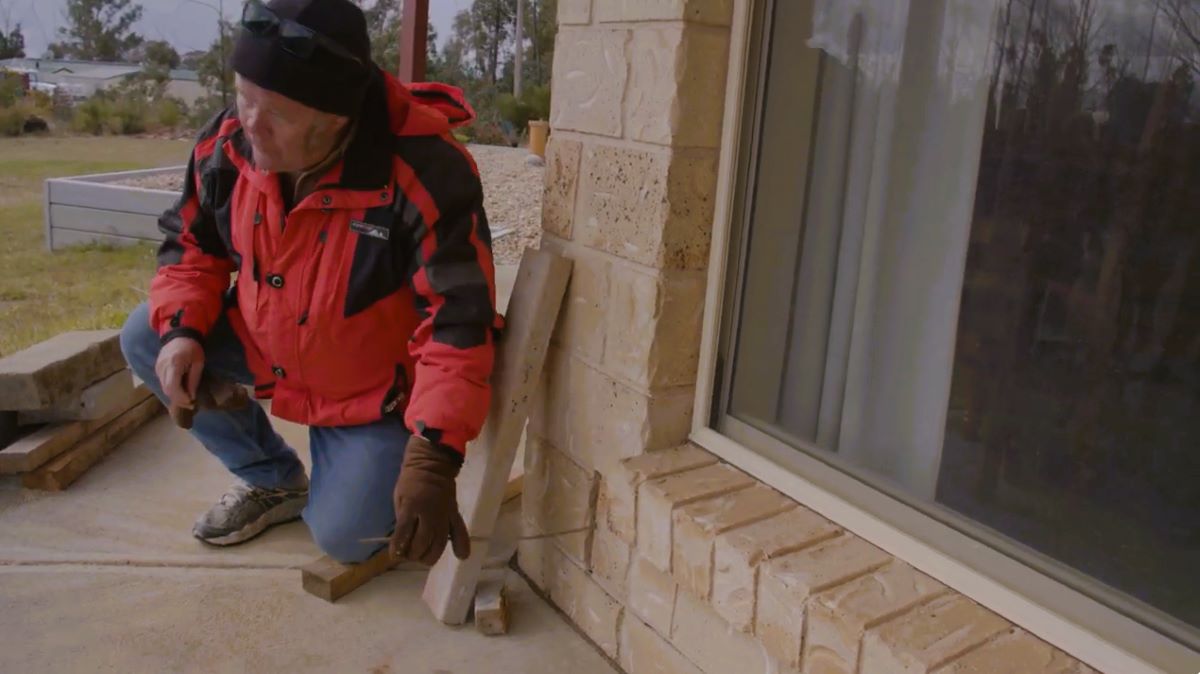
Gaps between bricks can allow embers to enter. In this case, there is a second layer of brick that would stop this.
Sprinklers under houses have also proved to be effective. Sometimes gaps at the bottom of walls clad in steel, such as Colorbond, allow embers to enter. Mesh or expanding foam are both materials that can be used to fill gaps.
Around the house
It’s essential to keep the house and its surroundings clean and clear of combustible material such as leaves and pine needles. A buildup of dried organic matter in the frame of a water tank for example, provides a site of ignition.
Cracks can appear in aging timber and paint can come off. Filling these gaps is important and painted wood provides better protection than bare wood. Grates in bricks also need to be meshed, especially if they expose timber floors to embers.
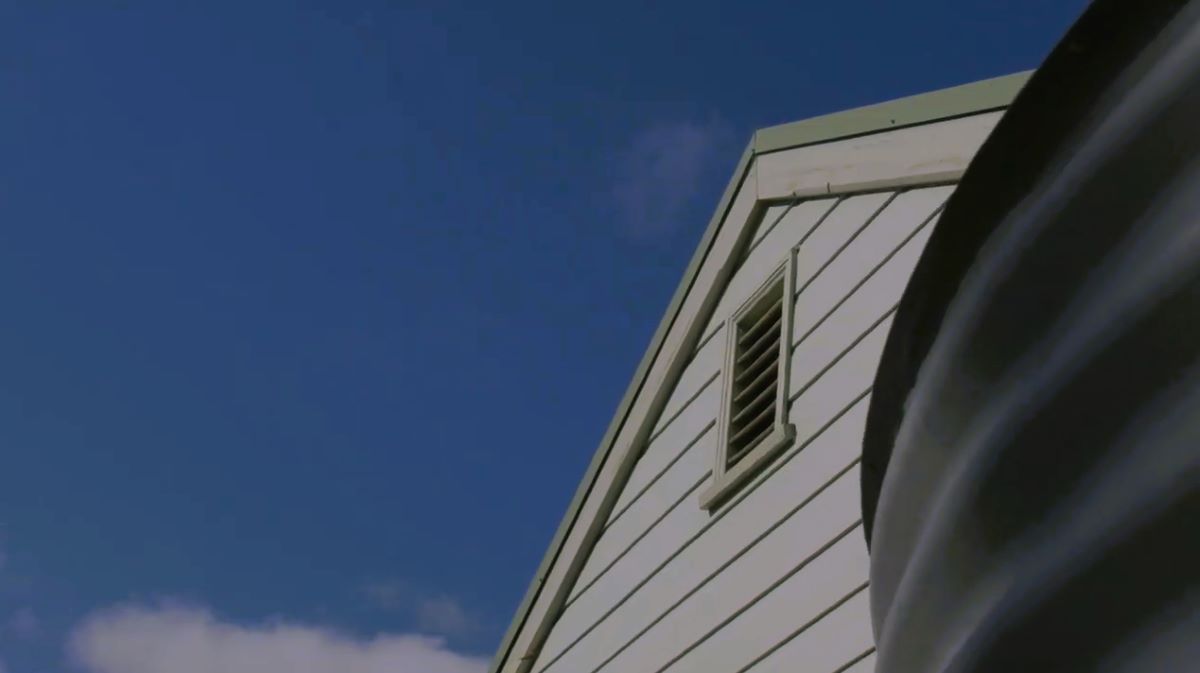
Tony points out another point of entry for embers and notices wood and paint cracking.
Vegetation
Vegetation next to the house can present a danger. With enough heat everything will dry out and burn. When shrubs or vines under windows and against walls combust, windows will break more quickly providing the fire with an ignition point directly against the house.
Trees near houses should be assessed. In a fire, trees can potentially fall on houses, especially if they are old and sick. Review Blue Mountains City Council and NSW RFS regulations and advice around Asset Protection Zones.
What ground cover and mulch you have around your home can affect how fire impacts you. Gravel mulch is best. Woodchip is better than grasses as even green plants will dry out and burn, given enough heat.
Guttering
Leaves can collect in valley gutters and act as fuel for embers. Gutter guards or regular cleaning of gutters can keep this to a minimum. Using a blower is an effective way of keeping gutters clear.
It is also of benefit to be able to fill your gutters with water during a fire. This means embers won’t land and continue to burn. Another place leaves and debris can build up is around and under solar panels. Keeping all these areas free of combustible material will make your home more resilient against fire.
Storage and Sheds
Storing things under and near your home can provide fuel for fires and make it more vulnerable to ember attack. These could include garden waste, sleepers, canoes, lawn mowers, or paint.
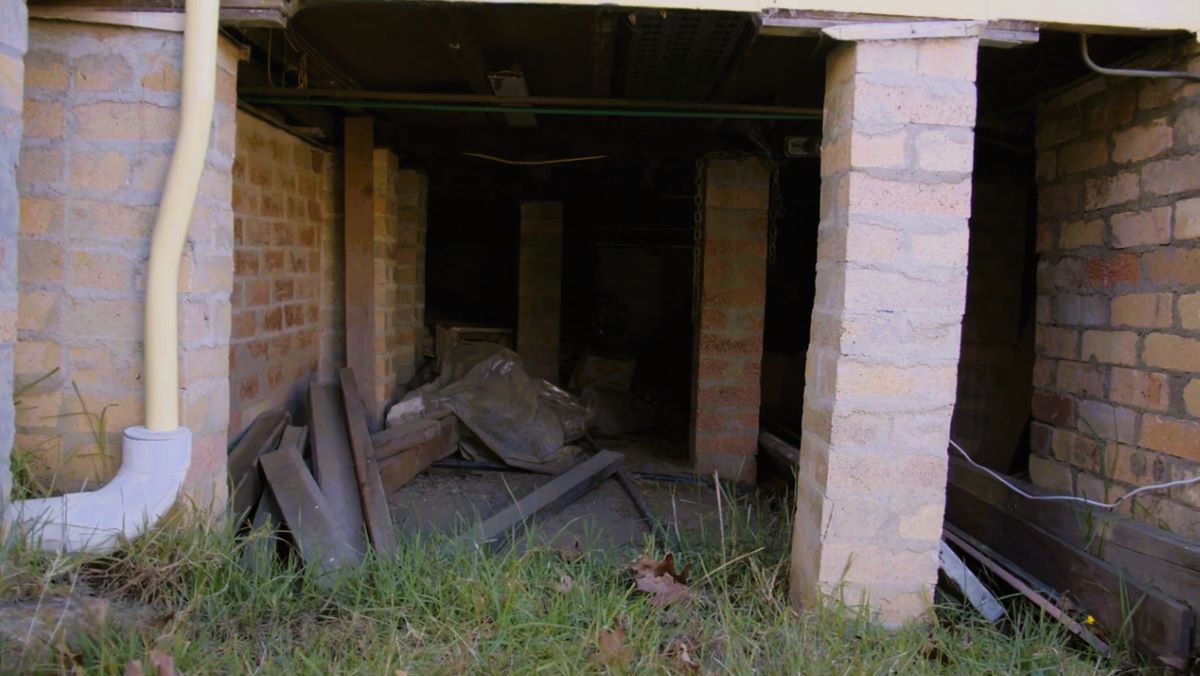
Storing combustible material under the house can assist fire. This image also shows exposed wooden rafters that could be ignited by embers.
Sheds need to be at least 6m away from your home. Sheds are not required to be built to the same construction standards as houses. Sheds can have more gaps, which makes them more vulnerable to fire.
What you keep in sheds must be considered too, as these areas can be more susceptible to fire. Under-house storage and garages and sheds filled with combustible material, such as paint and chicken feed, can be an issue. Burning outbuildings can potentially impact homes, too.
LPG Bottles
Gas bottles should be placed with their release valves facing away from the house. All fittings should be metal. It can also be helpful to situate them on the more fire-sheltered side of your home.

LPG gas bottles with the release valves pointing away from the house.
Sprinklers
Sprinklers can be an effective tool for mitigating fire risk. This is something that has been recognised in the communities of Bell, Clarence and Dargan. There is no formal building standard for sprinkler systems, but there are some rules of thumb to follow. These are fire consultant Tony Hawkins’ recommendations.
Tony says the biggest considerations with sprinkler systems are: who will turn them on, what generator/pump is used and how much water is available. The gold standard is copper piping with all-metal sprinkler heads. However, Tony says that PVC piping that is shielded with metal, can provide a system that still reduces your fire risk. (NB. The Blue Mountains Planetary Health Centre has a bushfire sprinkler display wall which can help you learn about the effectiveness of different sprinkler heads. You can arrange a visit to learn more by emailing planetaryhealth@bmcc.nsw.gov.au)
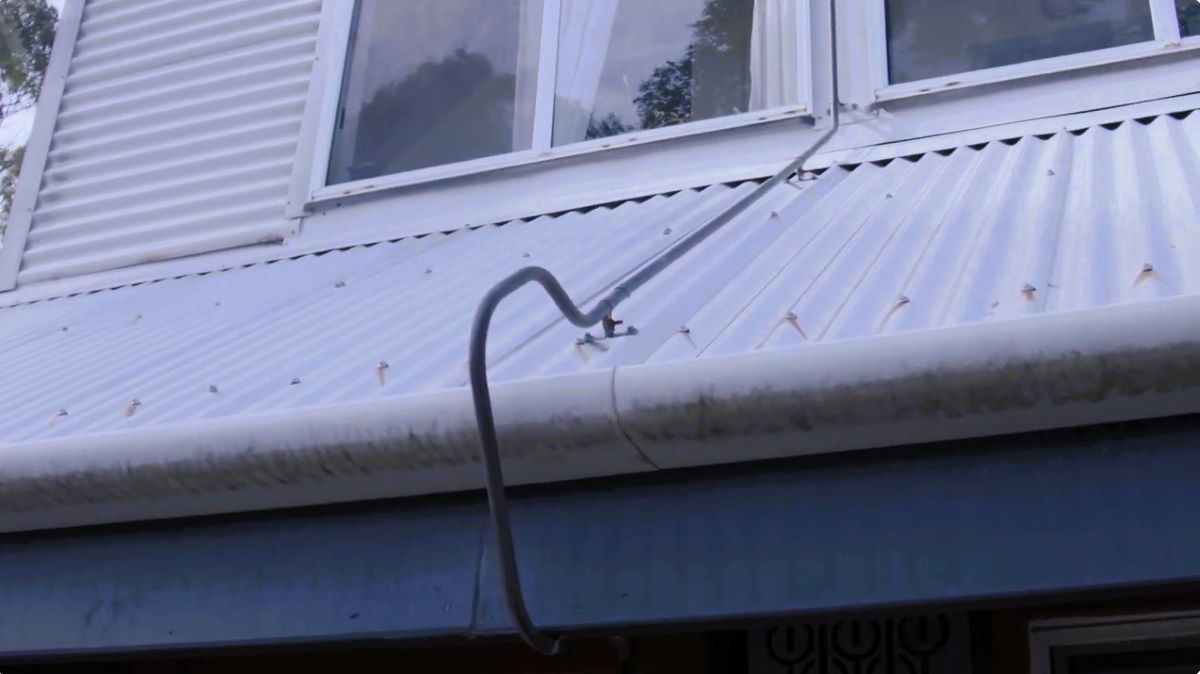
Part of an all-metal sprinkler system that helps protect the vulnerable area around the gutters.
Sprinklers can act against fire in various ways: from cooling down windows, to wetting gutters and roofs, to wetting decks and areas immediately adjacent to the house. Because the windows, decks and verandas are so vulnerable, protecting these areas with a sprinkler system should be the priority. Your local RFS branch can provide advice on the best configuration.
Modular parts for a sprinkler system can be bought from the local hardware store. A system installed by a plumber may be more comprehensive, but it might cost thousands of dollars. If you can install one yourself, Tony says the parts can cost less than $1000. He believes that a functioning system will provide better protection than no system at all, but he cautions that all systems have their limits.

Electricity is one of the first things to fail during fire. Sprinkler systems should be powered by petrol, or ideally diesel generator pumps.
The recommendation is a diesel-fuelled generator/pump because the electricity supply is prone to failure during a fire. Testing the generator at least once a month, preferably every two weeks, is key to ensuring it is ready for operation at a moment’s notice. A system must also be tested to ensure that it provides the expected coverage.
Water tanks
Water tanks are a fundamental part of a sprinkler system. Underground tanks are the most protected from fire. Metal tanks are more fire-resistant than plastic ones, but both will fail with enough heat. Your tanks’ performance is influenced by their materials, where they’re positioned and whether they are shielded.

Tony talking with community members about water tanks.
Fire consultant Tony Hawkins and ABCD Inc. wish everyone a safe fire season, now and in the future.
Note: This is not a complete guide to managing fire on your property. It is intended to raise some important challenges when facing fire and in some cases, provide possible solutions.
The NSW Rural Fire Service website has a wealth of information on the topics discussed here. Please also see the videos created by ABCD Inc.
In summary, a message from Kevin McCusker, President of ABCD Inc.
We are all vulnerable in an emergency. Have you ever wondered how prepared or mentally strong you are? Have you considered the day-to-day activities that may not be covered by your existing bushfire plan?
ABCD Inc. has created an emergency preparedness toolkit to encourage us to examine every aspect of our bushfire plan, whether it involves staying or leaving, and to ensure that we are truly prepared.
This toolkit will assist you in identifying the support needs of you, your family, and your pets in your daily life before and after an emergency event. Families, if you plan to evacuate, do you know what essentials to take with you if you must leave your home for days? Have you practiced packing your car?
If you are feeling overwhelmed with preparing your home and property remember that you are not alone.
There is a network of support available to help you through this process, offering a sense of reassurance and relief. Visit the following to learn more:
Association of Bell Clarence & Dargan Inc.
Blue Mountains Bushfire Resilience
Blue Mountains City Council Emergency Dashboard
Take Action:
- Preparing for fire needs to happen long before fire arrives.
- There are some basic things that you can do to make your property and home more resilient in the face of fire.
- The New South Wales Rural Fire Service (NSW RFS) website is an excellent place to find resources about how to make your home and property more fire resilient.
Share this article:
This story has been produced as part of a Bioregional Collaboration for Planetary Health and is supported by the Disaster Risk Reduction Fund (DRRF). The DRRF is jointly funded by the Australian and New South Wales governments.
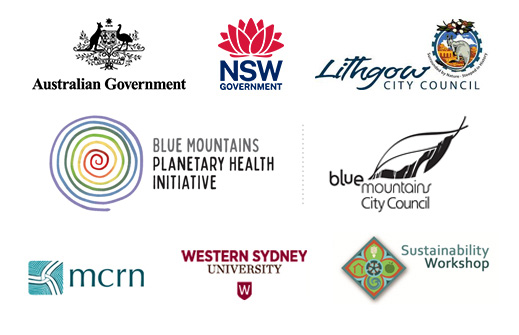
More from around the region
A huge thank you to Josh Logan from Logan Signs, Lithgow, for installing our Circular Water Signage in time for our World Animal Day Celebration today at the Blue Mountains Planetary Health Centre (33-39 Acacia St Katoomba). We have a full program of events with lots of information on how to prepare for the summer ahead and how to create urban areas that help us share our home respectfully with all species. It will be a fun family day too with storytime, craft and live music for kids! (Link in profile) #worldanimalday #planetaryhealth #familyday #katoomba #bluemountains
And our Wild Life exhibition is now up for World Animal Day tomorrow at the Blue Mountains Planetary Health Centre. Photographs by Warren Hinder, Merryl Watkins, Holly Kent and Tracy Burgess. Check out all the other events from stalls, talks, possum box demo, kid`s craft and animal storytime, plant based food and live music to Bushcare. @33-39 Acacia St Katoomba Link in profile. #planetaryhealth #worldanimalday #katoomba
Join the Blue Mountains Planetary Health Initiative at World Animal Day this Saturday 5 October for a discussion on the history of the Plant Based Food Movement in Australia and a discussion of exciting contemporary trends. It will be followed by a Plant Based Cheese Degustation to launch the Plant Inspired Community Cooking Project. This will be a series of cooking classes to introduce the community to plant based cooking techniques. The event is free but places are limited so bookings essential (link in profile): https://bit.ly/3Bzbwhu
#plantbasedcooking #worldanimalday #bluemountains #katoomba #planetaryhealth #communitycooking
We share the Blue Mountains with so many extraordinary beings but have you seen them and do you know their names? Do you know the difference between a Royal Spoonbill and an Eastern Shrike-tit, or the difference between a bandicoot and an antechinus? Come and check out our Wild Life Exhibition at World Animal Day this Saturday to learn more from the stunning photographs by Warren Hinder, Merryl Watkins, Holly Kent and Tracy Burgess. There will be also be a Breakfast with the Birds at 8.30am, Animal Storytime and Craft for kids from 10am, stalls, talks, food and live music. The day is free but please book via Eventbrite to help us cater (link in profile): https://bit.ly/4eMhbz0 @bluemountainswalks @merrylwatkinsphotography @bestofbluemountains
#royalspoonbill #easternshriketit #wildlife #birdsofthebluemountains #bluemountains #katoomba #worldanimalday #biodiversity #planetaryhealth
To coincide with the first day of Bushfire Season we launched Air Watch at the Planetary Health Centre yesterday. For the last seven years Blue Mountains Unions & Community have been working tirelessly to ensure residents of the Blue Mountains and Lithgow are able to measure and track the quality of the air we breathe. The Blue Mountains Planetary Health Initiative has worked closely with them over the last year and now there are 20 PurpleAir monitors distributed throughout the Blue Mountains and Lithgow, including one at the Planetary Health Centre. You can now view real time air quality measurements at each of our local news sites and on the Purple Air Map https://map.purpleair.com We have 10 more sensors available, so if you’d like to install a sensor, members of BMUC will be at World Animal Day at the Planetary Health Centre this Saturday 5 October to take applications and share more information about the project. Bookings for World Animal Day here (link in profile): https://www.eventbrite.com.au/e/world-animal-day-promoting-respectful-cohabitation-tickets-1029328889417
It was a fabulous day yesterday as each speaker highlighted how critically important this project is: Dr Rosemary Dillon CEO of Blue Mountains City Council Trish Doyle MP Dr Jenna Condie from Blue Mountains Parents for Climate Dr Maggie Davidson, environmental scientist from Western Sydney University Matthew Riley, Director Climate and Atmospheric Science from NSW Department of Climate Change, Energy, the Environment and Water and Peter Lammiman and Ann-Maree McEwan from the BMUC’s Airwatch Committee.
@bluemountainsunionists @nswdcceew @bluemountainscitycouncil @westernsydneyu @trishdoylemp @parentsforclimatebluemountains #airqualilty #airqualitymonitors #bluemountains #planetaryhealth
Treat yourself this weekend with a fun-filled and informative World Animal Day event at the Planetary Health Precinct in Katoomba. As well as a Breakfast with the Birds, stalls and a possum box demonstration, there will be a fabulous wildlife exhibition with photos by Warren Hinder, Merryl Watkins, Tracy Burgess and Holly Jayne; live music with Mem Davis, Joe Flood and Duck Keegan; lots of fun for kids with Sharon Baldwin and Naomi Crew leading animal storytime and craft with Julie Refferty; delicious plant based, gluten and dairy free treats, pastries and donuts from Clean Cravings; a plant based cheese degustation and warming Dahl, rice roasted cauliflower with veggies, pakoras, tamarind chutney, and salad courtesy of Bibi’s Kitchen. Come and learn more about Blue Mountains Bird Observers, Blue Mountains Conservation Society, WIRES, Action for Animals Blue Mountains and Animal Sanctuaries, Wombat Rescue, the Women’s Shed, and Animal Welfare Laws in Australia.
Guest speakers throughout the day will include Elizabeth Ellis, lecturer and author of Australian Animal Law; Hal Ginges, a local lawyer and animal activist from Action for Animals who advocates for animal rights and raises money for sanctuaries; Mark Berriman who has been President of the Australian Vegetarian Society NSW since 1989, as well as Co-ordinator for Animal Liberation NSW, Director of the Natural Health Society of Australia and the World League for Protection of Animals; and Teya Brooks Pribac, a researcher in the area of animal studies and the award-winning author of Enter the Animal. She’s also published Not Just Another Vegan Cookbook and will be sharing her culinary skills with the community in the Plant Inspired Community Cooking Project.
The event is free but please book your place to help us cater (link in profile): https://www.eventbrite.com.au/e/world-animal-day-promoting-respectful-cohabitation-tickets-1029328889417
#worldanimalday #plantbased #planetaryhealth #katoomba #bluemountains
We are so looking forward to kicking off World Animal Day Celebrations on Saturday 5 October with an 8.30am Breakfast with the Birds. Join Paul Nagle from the Blue Mountains Bird Observers on a guided bird walk around the Planetary Health Precinct visiting different habitats on the site to observe and talk about the birdlife that is resident and that visits the site. Binoculars are highly recommended.
World Animal Day will be an inspiring family day celebrating the extraordinary diversity of animals we share our world with! The theme is `Promoting Respectful Cohabitation`. Bookings for the Breakfast with the Birds (link in profile)
or here:
https://www.eventbrite.com.au/e/breakfast-with-the-birds-tickets-1028664983657
#birdlife #breakfastwiththebirds #katoomba #worldanimalday #bluemountains #planetaryhealth #respectfulcohabitation
We all need clean air to breathe, but how can we tell how clean our air is?
Thankfully the Air Watch subcommittee of Blue Mountains Unions & Community has worked for years to find ways to help us measure the quality of the air we breathe. Over the past year the Blue Mountains Planetary Health Initiative has worked with them to install Purple Air Quality monitors across our bioregion from Lithgow to the Lower Mountains. You can now view real time air quality on each of our Local News Sites!
Air Watch`s Purple Air quality monitors give the Blue Mountains` 78,000 residents, workers and 3 to 5 million/year visitors the power to make timely, informed decisions about their activities and health. It will also be a reliable source of data for the scientific community.
To coincide with the start of the Bushfire Season on Tuesday 1 October, we`re inviting the whole community to join us to launch Air Watch Blue Mountains and Lithgow at the Planetary Health Precinct. If you`d like to join us book a place here https://bit.ly/4dp2qko (link in profile)
#airquality #purpleair #bluemountainsunionscouncil #planetaryhealth #bluemountains #katoomba #bushfireseason
Today`s the day for the Blue Mountains Sustainability Festival! @bluemtns_sustainability_fest
We`ll be at the Speakers Forum at the Blue Mountains Cultural Centre at 10.15, talking about volunteer opportunities with the Blue Mountains Planetary Health Initiative, and then giving a presentation at 2.30pm. There`s a jam-packed speakers program, community stalls and workshops, and a Shopping Trail through Katoomba and Leura. You can find more information on the website at https://resilientbluemountains.org/sustainability-festival/
#sustainability #slowfashion #slowshopping #fashiontrail #circulareconomy #planetaryhealth #community #katoomba
Our newsletter is out! Read about the Blue Mountains Sustainability Festival this Saturday, the Air Watch Launch next Tuesday and the upcoming World Animal Day: Promoting Respectful Cohabitation Event at the Planetary Health Precinct on 5 October. And check out the comprehensive Springwood & Lower Mountains Repairers Guide (link in profile): https://bit.ly/3TJiKFR
You can subscribe to receive this newsletter via any of our local news sites.
#sustainability #biodiversity #worldanimalday #airwatch #airqualitymonitors #sustainablefashion #circulareconomy #planetaryhealth


